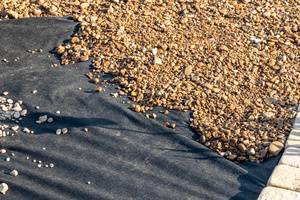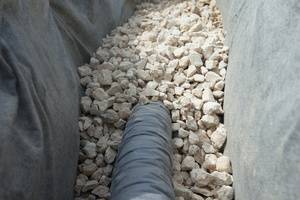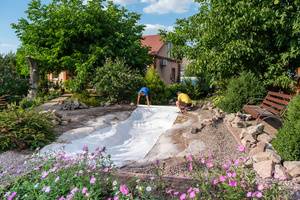If you are working on a gravel driveway installation or another type of project involving soil and gravel, you may have been advised to use geotextile fabric. Geotextiles can be used in construction projects to help improve the characteristics of soil. For example, they can help to make poor soil easier to manage so that construction can be carried out in places that might otherwise not be feasible. They can also help facilitate infrastructure works.
One of the most common uses of geotextile fabrics in residential sites is for enhancing the performance of gravel driveways. Here is a look at the characteristics of geotextile fabric and how to use it in your driveway project.
Separation

Geotextile fabric can be placed between two different types of soil in order to separate them. For example, it may separate dissimilar materials to allow the soil to obtain certain characteristics. This means that when water makes its way into the soil, the different layers will not mix. This can be useful in road constructions, where keeping fine subgrade aggregate from mixing with the coarse aggregates in the bottom layer is desirable. This allows it to maintain its drainage characteristics by stopping fine aggregate from making its way into the voids between the bigger aggregate.
Geotextile fabric used for this purpose will have the right thickness and permeability to keep the soil from becoming contaminated while enabling water to flow through it without compromising the road’s structural capacity.
Reinforcement
The type of geotextile fabric that is used for improving the characteristics of soil is designed with load supporting, changes in bearing, and friction in mind. For example, reinforcing geotextile fabric can be used on a road or embankment that is being built on poorly graded soil to facilitate deeper embankments. In these cases, a geotechnical engineer will provide the proper design parameters.
Sealing
Geotextile fabrics can be infused with asphalt or similar mixes to make it impermeable so that it can stop the flow of liquids in both directions. A non-woven material is used for these types of geotextile fabrics. They are useful for stopping soil or groundwater from being contaminated by pollutants or stopping potable water from being lost to evaporation.
Filtration
Geotextile fabrics can be used for filtration by allowing water to move in two directions. Either non-woven or woven fabrics can be used for this purpose. Depending on the material’s porosity and permeability, it can also be used to promote the lateral flow of drainage water.
Geotextile fabrics can be used both vertically and horizontally to solve various drainage problems around homes, roads and curbs.
Using Geotextile Fabric For Gravel Driveways

Given the many helpful functions that geotextile fabrics serve, it is easy to see why so many homeowners use geotextile fabrics in gravel driveways.
When geotextile fabric is placed beneath a gravel driveway, it helps you to avoid the need to regularly add more aggregate base to the driveway. It can form a layer of separation and stabilization that reduces not only the amount of gravel that is required during initial installation but also in future maintenance works. Its high tensile strength provides a good separation between the gravel of the driveway and the earth below, and using it can reduce the overall cost of a gravel driveway project.
Here is a look at the steps involved.
Choosing Your Geotextile Fabric
For driveway paving, a woven geotextile fabric with a high tensile and grab strength is ideal because it will withstand the weight of heavy vehicles over time. The drainage at your site should guide your choice, but standard-grade fabric is usually sufficient for residential applications.
Preparing the Site
First, you will want to remove vegetation from the area, such as grass and shrubs. Then, ensure that the subgrade soil’s surface is smooth and level and there are no high spots or depressions. You will want to create a path that is as flat as possible so that there will be a good foundation for your fabric and aggregate base.
Installing the Fabric
Woven geotextile fabric should be rolled in the direction indicated by the plans for the project as this will ensure that the pathway is durable and high performing.
Securing the Fabric With Staples
Once you have rolled out your fabric and positioned it, you must secure it so it will remain in place. 6-inch landscape staples or pins can be used to secure your fabric to the ground so that it will not move or shift over time. Experts recommend placing one staple for every square yard of material. If you only need to staple the sides and center, plan to use one staple for every three linear feet.
Spreading the Base Material

Next, you will want to spread your base material across the top of your geotextile fabric. If you will be adding aggregate rock to the driveway, you need to aim for a layer that is at least 8 to 12 inches in depth over your fabric, although some types of projects may require a greater depth. If you need to drive over the fabric before you have laid the base to dump the crushed rock, be sure to proceed slowly and avoid abrupt stops or sharp turns that could damage the fabric.
Once the base has been laid, the gravel should be compacted with a compacting tool.
Repairing Geotextile Fabric
If you accidentally puncture through an area of your geotextile fabric, do not panic. It can be easily repaired by placing another layer of fabric across the damaged portion, making sure to overlap it by at least three feet in each direction around the damaged area.
Contact the Gravel Driveway Contractors
If you need geotextile fabrics for any type of residential or commercial project, get in touch with the experts at Dirt Connections. We offer a broad range of driveway-related services throughout the Northern Virginia area, including gravel driveway installation, dirt grading, site work and paving. Contact us today to discuss your project and learn more about our services.
Summary

Dirt Connections was started with one goal in mind: providing quality residential and commercial construction services to clients on time and on budget. Reach out for more information on how we can support your next project.
For your convenience our estimates are free and by appointment. Call 703-940-9949 for a free estimate today!










































